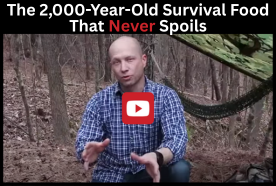Why Thankfulness Keeps You Sharp – Survivopedia

Most people think survival is all blood, sweat and steels and they often imagine knives, fire starters, water filters, ammo and what not when this subject is brought up. That’s the visible stuff, but anyone who has spent time in real hardship knows there’s something more. There is a tool that never shows up in gear lists, never weighs an ounce, and yet determines whether you stay sharp or spiral. That tool is gratitude.
The kind of gratitude that keeps a person levelheaded when things get ugly, the kind that stops panic from taking the wheel. That gratitude that sharpens your thinking rather than clouding it. It is a mental anchor and in certain situations it is the only thing that keeps your mind from slipping into despair or tunnel vision. And in any crisis, mindset is often the first thing to fail.
This article takes a hard look at why thankfulness matters when the stakes are high, how it affects the brain, why it improves group survival, and how to train it long before you need it. Gratitude isn’t soft and I consider it to be a discipline, a skill and a survival tool. However, just like any tool in your kit, it works only if you practice using it.
The Mindset Determines Survival Outcomes
When people picture collapse situations, they usually imagine themselves using tools, muscle memory, and gear. But the truth is that your brain is your first and last piece of survival equipment. I’ve stressed this before and folks should understand that every action flows from your mindset: how you process fear, how you interpret danger and how you decide what to do next.
Panic destroys judgment and fear narrows focus until you stop seeing options. Stress drains energy and makes even simple decisions feel overwhelming during your day-to-day life. Now image what would occur if you find yourself in a life-threatening situation. In most cases, people make fatal errors: lighting a fire where they shouldn’t, wandering instead of hunkering down, drinking unsafe water because the brain refuses to slow down long enough to think.
Gratitude flips that script by grounding your attention. When you deliberately acknowledge what’s going right, even if it’s the basics of things you can think of, you interrupt the stress cycle. Now, we shouldn’t be absurd and we need to acknowledge that this doesn’t magically fix the crisis, but it stops your mind from spinning off into worst-case scenarios. You make clearer calls and you conserve mental energy. It helps you stay adaptive instead of reactive.
To sum it up, gratitude is a mindset stabilizer and as I’ve said it hundreds of times, it not more, only stable minds survive.
What Gratitude does to the Brain when SHTF
There’s nothing mystical in this article and this is not a discussion about faith. Gratitude literally changes brain chemistry in ways that matter during hard times and when you practice gratitude, your brain releases a cocktail of dopamine and serotonin. Just enough to counteract the cortisol and adrenaline that flood you under stress. This balances your emotional state, which keeps your thoughts from collapsing inward on fear alone.
More importantly, gratitude broadens your attention and studies show it even improves situational awareness by making your brain scan for what’s working, instead of only what’s failing. In survival conditions, that shift can mean noticing a water source you would’ve missed, an escape route you wouldn’t have considered, or a tool you overlooked.
Gratitude also reduces impulsiveness and that’s a critical advantage when there’s chaos around you. People in panic states act without thinking, and panic kills. However, a grateful brain pauses just long enough to override that instinct and it’s like having an internal safety switch.
The “Thankful Warrior” Mindset
A “thankful warrior” isn’t cheerful, but rather disciplined. They see scarcity without letting it break them and they acknowledge danger without surrendering to it. Gratitude becomes part of their mental arsenal. The thankful warrior mindset doesn’t say, “Everything is fine.” It says, “This part is still working and I can work with that.”
That difference changes everything in a survival situation.
When you’re cold, wet, and exhausted, it’s easy to fixate on discomfort. However, the warrior mindset turns the focus toward practical advantages. You might be low on food, but you still have plenty of water. You might be alone, but you still have mobility. And perhaps you might be shaken after surviving an accident, but you are alive and capable of acting.
Gratitude repositions your brain from helplessness to action, and in survival scenarios, that brings empowerment. People who believe they can act do act, but folks who believe they’ve already lost give up. The sad part is that, sometimes, they give up long before the situation becomes truly desperate.
Historical and Modern Examples of Gratitude Under Pressure
This principle isn’t new and people have used gratitude as a survival tool long before the modern prepping movement.
For example, frontier homesteaders often recorded in diaries how gratitude for small wins kept them going: a healthy calf born in winter, a break in the weather or a neighbor who showed up with a sack of grain. Life was brutal back then, but thankfulness kept their spirits from collapsing.
Military survival accounts repeatedly reference gratitude as a stabilizer. Soldiers stuck behind enemy lines often stayed mentally sharp by focusing on small blessings: a working compass, a clear night sky, or even just the fact that they weren’t injured. Those moments of appreciation kept their morale from tanking and they helped them push forward.
I’ve did a lot of disaster relief work, both inside and outside the country and I’ve seen firsthand survivors speak of gratitude as a lifeline. After hurricanes, earthquakes, or long-term power outages, people who cope best are usually the ones who focus on what still exists rather than what was lost. That mindset fuels problem solving rather than despair if you’re able to trigger that safety switch I’ve mentioned before.

Gratitude Also Improves Group Survival and Reduces Conflict
Stress exposes the cracks in group dynamics and it’s often the downfall of the team. One sour attitude spreads like infection, dragging morale down and pushing people toward conflict. Gratitude works as a social stabilizer and improves morale.
A grateful person expresses appreciation, and this builds trust. Where there is trust, there is less conflict and that means more cooperation. We’ve discussed, on other occasions how cooperation is a survival multiplier. In fact, throughout our history, empires were built on two things, a surplus of food and cooperation.
Groups with gratitude-driven members share resources better, communicate more clearly, and stay aligned on goals. They’re less likely to split, panic, or turn on each other when push comes to shove. Gratitude reminds everyone of the bigger picture and prevents the spiral into blame and resentment.
Even in a small family bug-in scenario, thankfulness smooths edges and when everyone’s tired, hungry, and scared, a single moment of appreciation can diffuse tension before it ignites. In war times, for example, gratitude becomes a form of leadership, not through dominance, but through stability.
Training Your Gratitude Muscle Before a Crisis Hits
Like any other skill, gratitude works best when it’s trained long before the lights go out.
I encourage you to begin with small, consistent habits. Every morning or evening, take 60 seconds to note three things going right for you. Not abstract concepts, but tangible stuff like a working body, a tool you trust, a roof over your head, someone you care about. The point is to teach your brain to spot advantages quickly. Even a cold beer after a good day’s work trains that gratitude muscle.
You can also use gratitude as a mental warm-up during prepper practice. Before starting a fire drill, a food-storage rotation, or a map-reading exercise, note what you appreciate about the opportunity. This trains your mind to enter stressful simulations with a balanced emotional baseline.
The goal isn’t feel-good vibes and your aim is a brain that stays functional under stress. Gratitude is mental conditioning and you’re building neural habits that will keep you sharp when things get dark.
Field-Ready Gratitude Practices You Can Use in an Emergency
When you’re in the thick of a crisis, you won’t have time for long reflections. You need gratitude practices that work fast. Here are a few exercises I’m practicing during my extended outings. I’ve made a habit of “getting myself lost” in the wilderness to test both my physical and mental skills. The following works for me and I hope they will work for you as well.
One: Identify one working advantage.
It might be “I have dry socks,” “My knife is sharp,” or “I have five minutes to think.” That single detail can interrupt the panic loop. For example, I love camping in the winter and making a fire in challenging situations is my gratitude when it’s freezing outside.
Two: Use gratitude as a grounding technique.
Acknowledge something you’re thankful for, then immediately take a physical action like tightening your pack straps, adjusting your footing, checking your gear. This pairs gratitude with movement, anchoring your body and mind.
Three: Pair gratitude with scanning.
State one thing going right, then look for the next option or resource. This trains your brain to shift from fear to strategy. For example, I have a good sleeping bag that keeps me warm during cold nights, but the best next thing, is using a beanie when sleeping.
Four: Use gratitude to reset after mistakes.
Instead of spiraling into self-criticism, say, “I’m grateful I caught that error before it got worse.” This reduces emotional crash and restores clarity.
These tiny habits may not look like much, but I assure you, they can keep your mind from collapsing under pressure. I consider them to be the survival version of tactical breathing.
Avoiding Toxic Positivity
Gratitude is not denial and you must understand that it’s not pretending everything is okay. You shouldn’t be forcing yourself to be cheerful when the situation is brutal. Toxic positivity ignores danger and that’s what gets people killed. Real gratitude faces the danger and chooses to stay mentally functional anyway.
Being thankful doesn’t mean overlooking risk or sugar-coating reality because you’re only going downhill from there. It means staying grounded enough to handle that reality with a clear head. A balanced practice of gratitude acknowledges the problem and the advantage simultaneously.
You can say, “This is bad, but I still have options.” That’s survival mindset and it keeps your brain from freezing.
The right gratitude practice won’t blind you to danger and in certain cases, it may be the only thing to help you navigate it.

Concluding
When the world gets loud, gratitude keeps your mind quiet and when fear spikes, gratitude keeps your judgment intact.
You can store food, stack tools, train skills, build shelters, and sharpen blades, but none of it matters if your mind breaks under pressure. Gratitude is the invisible gear that keeps everything else running.
A person who practices thankfulness stays sharper, calmer, and more aware. They make better choices and they avoid panic. Sometimes they stabilize others and they help the entire group survive.
And the best part is that gratitude weighs nothing, costs nothing, takes no space, and cannot be lost or stolen. So, why not pack it now, train it often and use it when it counts?






Read the full article here









